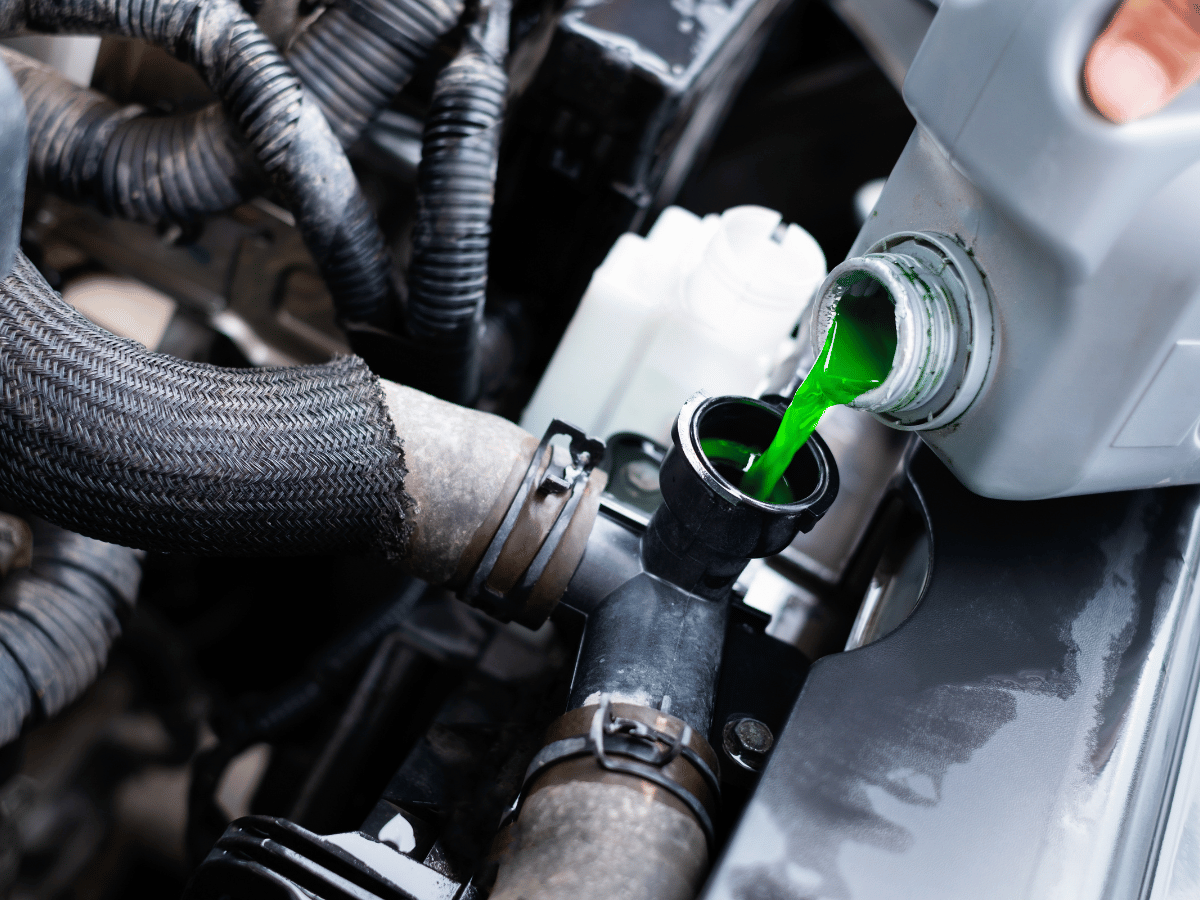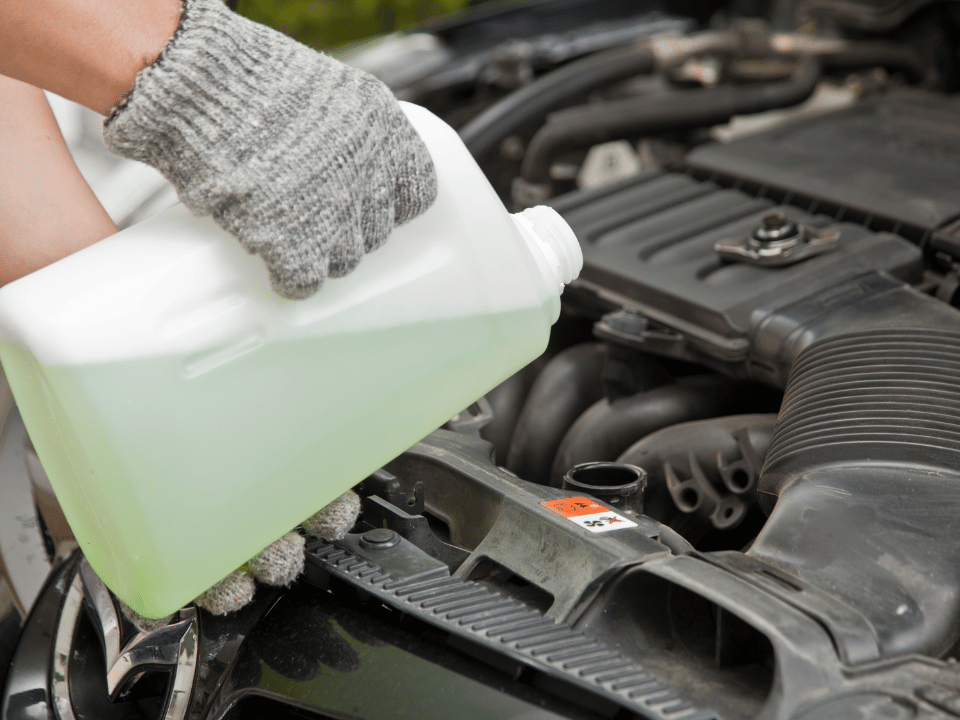Expert Guide to Toyota RAV4 Coolant: Avoid Overheating
Your RAV4 has many different fluids, all with a unique purpose. One of the most essential fluids is the coolant. Without coolant in your RAV4, the engine would overheat and fail. Checking and changing the Toyota RAV4 coolant is all part of regular maintenance.
In this article, I will help you understand what makes coolant so critical to the engine’s well-being and show you how often it should be changed. I also list the types of coolant that should be used based on the model you drive.

Understanding Coolant
Engine coolant is often called antifreeze, yet these terms describe differing fluids.
- Antifreeze: Made from ethylene glycol or propylene glycol, is the basic ingredient of coolant
- Coolant: Mixture of antifreeze and water, usually in a 50-50 ratio
Coolant is a mixture of antifreeze and water, usually in a 50/50 mix. However, some cars require 70% antifreeze and 30% water, especially when driving in frigid cold climates. The 50/50 blend can protect the engine when operating at more than 200 degrees Fahrenheit and in temperatures of 30 degrees below zero.

Engine coolant has more than one purpose. Here are just a few of its uses:
- Keeps the motor from overheating
- Lubricates the engine’s moving parts
- Prevents damage to the head gasket, water pump, engine block, and cylinder head
- Prevents corrosion
Engine coolant transfers the heat from the motor to keep it cooler. It runs through the closed cooling system, from the engine to the radiator and back again.
Checking the Level
If there’s not enough coolant in your RAV4, the temperature gauge may start to climb into the hot zone (H). When the temperature gauge gets into the red zone, serious damage is sure to follow. The engine can be destroyed, which is an expensive repair.
For that reason alone, it’s important to check the RAV4 coolant level regularly.
The RAV4’s coolant reservoir is located on the left side of the engine bay in a large white container. The cap will be labeled indicating that it is the coolant reservoir.

Here’s our quick video tutorial explaining how to check the coolant level, or you can continue reading for written instructions.
Before you check the coolant, heed my warning. Don’t remove the coolant reservoir or radiator cap if the engine is hot. Coolant is under pressure, and you could be sprayed with scalding hot coolant, leading to severe burns. Always allow the engine to cool off first.
Here are some simple steps to checking the coolant.
- Park your RAV4 on a level surface
- Engage the parking brake
- Turn off the engine
- Open the hood, but don’t touch the radiator, hoses, or engine. These parts are very hot and can burn you.
- Locate the coolant reservoir. It is to the left of the engine compartment.
- Check the side of the reservoir to see how much coolant is inside. If the reservoir is dirty, you may need to wipe it off.
On the side of the reservoir are lines indicating when the system is full and when it is low. If the coolant falls anywhere between the “LOW” and “FULL” lines while the engine is cold, there’s enough in the system and you do not need to refill it.
If the coolant is below the “LOW” line, you’ll want to add more fluid. After topping it off, remember to recheck the coolant level periodically. If it continues to drop, there could be a leak that needs to be repaired.
(AutoZone)
How Often to Change
While it’s important to top off the system whenever it gets low, Toyota also recommends changing the coolant occasionally. The old coolant is flushed out, and the system is refilled with fresh fluid during this process.
As part of the RAV4 maintenance schedule, Toyota recommends inspecting the engine coolant every 15,000 miles or 18 months, whichever comes first.
If the fluid looks contaminated at these inspections, you could flush the system. It’s also important to top off with fresh fluid if the levels drop.
However, I’ve never had to top off the coolant in my 2021 RAV4. While I check it at the recommended intervals, there’s never been an instance where I’ve needed to add or flush fluid.
Aside from topping off the fluid, Toyota recommends flushing it every 100,000 miles (or 120 months). Doing this helps to ensure the engine receives the protection it needs.
Aside from using an extended-life antifreeze, there’s no way to make the coolant last longer. Toyota does offer an extended service formulation that goes 150,000 miles between changes, but it still has a maximum life of 120 months or ten years.
Choosing the Correct Coolant Type
It’s always best to stick to the manufacturer’s recommendations for your RAV4. Depending on the model and the year, the recommendations vary. Here are some suggestions.
RAV4 Gas Model
- 2004-2023: “Toyota Super Long Life Coolant” – a mixture of 50% coolant and 50% deionized water.
- 2000-2003: Use a 50% solution for protection down to −35C (−31F). A 60% solution is recommended for protection down to about −50C (−58F). Avoid using more than a 70% solution for better coolant performance.
- 1996-1999: “Toyota Long Life Coolant” or equivalent with ethylene−glycol type coolant. Avoid alcohol-type antifreeze or plain water alone. Use a 50 % solution to provide protection to about –35C (–31F).
RAV4 Hybrid Model
- 2016-2023: “Toyota Super Long Life Coolant” – a mixture of 50% coolant and 50% deionized water.
RAV4 Prime Model
- 2021-2023: “Toyota Super Long Life Coolant” – a mixture of 50% coolant and 50% deionized water.
Coolant Capacity
It’s critical that you put the right amount of coolant into the RAV4. If you don’t put enough coolant in (underfill), here are some possible consequences.
- Engine will overheat, leading to permanent damage
- Vital components won’t be lubricated and could fail
- Air gets into the system
Yet, you don’t want to overfill the system either. Here are a few consequences of putting too much coolant into the system.
- Spilled coolant gets on the engine and other components
- Electronics become damaged
- Leaks occur from excessive pressure
Stick to filling the tank to just below the “FULL” line. Here are the total capacities based on the information from Toyota.
RAV4 Gas Model
2000-2023:
- Without engine oil cooler: 7.3 qt. (6.9 L, 6.1 Imp. qt.)
- With engine oil cooler: 7.4 qt. (7.0 L, 6.2 Imp. qt.)
1996-1999:
- Manual transmission: 8.0 (8.5 L, 7.0 Imp. qt.)
- Automatic transmission: 7.7 (8.1 L, 6.8 Imp. qt.)
RAV4 Hybrid Model
2022-2023:
- Gasoline engine 6.4 qt. (6.1 L, 5.4 Imp. qt.)
- Power control unit 1.7 qt. (1.6 L, 1.4 Imp. qt.)
2019-2021:
- Gasoline engine 7.1 qt. (6.7 L, 5.9 Imp. qt.)
- Power control unit 2.1 qt. (2.0 L, 1.8 Imp. qt.)
2016-2018:
- Gasoline engine 7.9 qt. (7.5 L, 6.6 Imp.qt.)
- Power control unit 1.6 qt. (1.5 L, 1.3 Imp.qt.)
RAV4 Prime Model
2021-2023:
- Gasoline engine 8.7 qt. (8.2 L, 7.2 Imp. qt.)
- Power control unit 2.1 qt. (2.0 L, 1.8 Imp. qt.)
Does Color Matter?
Coolant is available in a variety of colors.
While it is not the color itself is not an active element of the chemical mixture, it does indicate the type of coolant you are using. It is vital to choose the right type of coolant, as it directly impacts the cooling system and engine. Using the wrong type can cause damage.
The most common colors of coolant are green, orange, pink, and yellow.
- Green: generally reserved for standard automotive applications
- Orange: used for heavy-duty applications and diesel motors
- Pink: used for newer models
- Yellow: used for older vehicles
Common Coolant Problems
The RAV4 doesn’t seem to suffer from a lot of coolant issues. However, there are a few complaints online worth noting.
- According to RepairPal, “The most common reasons a Toyota RAV4 has a coolant leak are loose hose connections, a broken radiator, or a failed water pump.”
- User Aimepac writes on the RAV4World Forum, “I have been experiencing significant coolant loss with no visible leaks.”
- User BamZipPow also responded to a problem posted on Toyota Nation and said, “There can be some air trapped in your cooling system and that it will drop the overflow reservoir down a little. You can top it off to the MAX line and keep an eye on it over the next few days.”
- User PatFlynnEire posted this information on Reddit. “A week after I paid $600 to have a Toyota dealer overhaul the coolant system on my RAV4, my hood started smoking, and there was coolant all over the engine block. The dealer had reinstalled this part, which was supposed to connect three hoses.”
If you notice any coolant leaks or have trouble with the cooling system, take your RAV4 to a qualified mechanic for diagnosis. Putting off the repair may cost you the engine, so don’t wait.
Conclusion
With the right amount and proper type of coolant in your RAV4, you have minimal worries about overheating. Following the recommended maintenance schedule is the best way to ensure the cooling system operates as it should.
If you want your RAV4 to provide you with many miles of adventure, you must take care of it. Check the reservoir often and top it off if needed. If you notice any problems, it’s time to have the RAV4 inspected by a professional.
